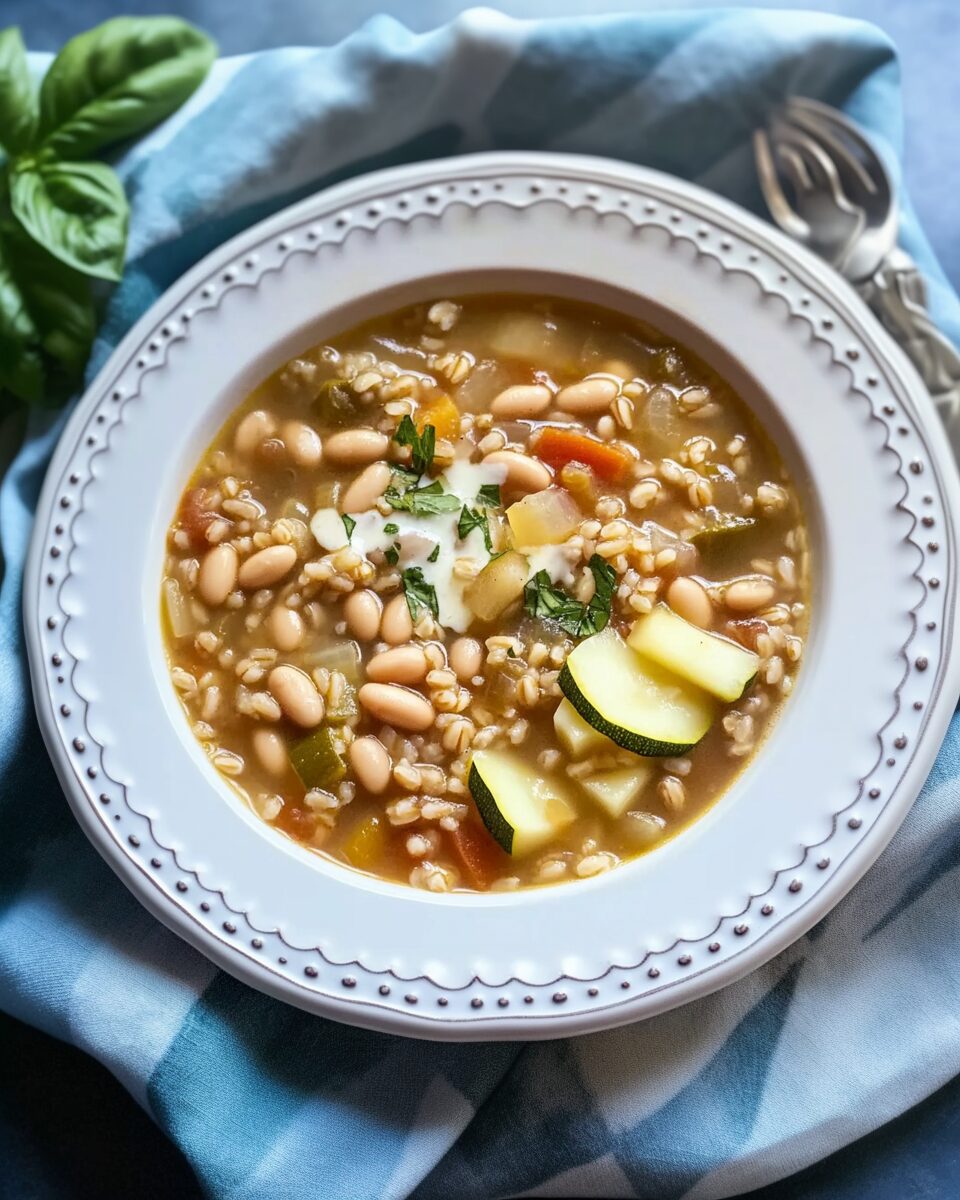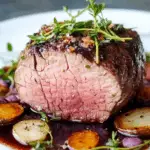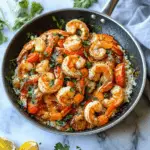This Summer Farro Soup is a hearty yet light dish that celebrates the bounty of summer vegetables. Combining the nutty chewiness of farro with the creaminess of cannellini beans and the freshness of zucchini, corn, and wax beans, it’s a comforting meal perfect for warm days.
Full Recipe:
Ingredients
- 1 tablespoon olive oil
- 1 medium onion, diced
- 2 cloves garlic, minced
- 1 Anaheim chile, diced
- 1 medium zucchini, diced
- 1 cup yellow wax beans, trimmed and cut into 1-inch pieces
- 1 cup corn kernels (fresh or frozen)
- 1 (15-ounce) can cannellini beans, drained and rinsed
- ½ cup pearled farro
- 4 cups vegetable broth
- Salt and freshly ground black pepper, to taste
- Grated Swiss cheese, for serving (optional)
Directions
- In a large pot, heat the olive oil over medium heat. Add the diced onion and sauté until translucent, about 5 minutes.
- Add the minced garlic and diced Anaheim chile to the pot. Cook for another 2 minutes until fragrant.
- Stir in the diced zucchini, wax beans, and corn kernels. Cook for 5 minutes, allowing the vegetables to soften slightly.
- Add the drained cannellini beans and pearled farro to the pot. Pour in the vegetable broth and stir to combine.
- Bring the mixture to a boil, then reduce the heat to low. Cover and simmer for 30–35 minutes, or until the farro is tender.
- Season the soup with salt and freshly ground black pepper to taste.
- Ladle the soup into bowls and top with grated Swiss cheese if desired. Serve hot.
Nutritional Facts
Note: Nutritional values are approximate and can vary based on specific ingredients used.
- Calories: Approximately 250 per serving
- Protein: 10g
- Carbohydrates: 40g
- Fat: 5g
- Fiber: 7g
- Sugar: 5g
- Sodium: 300mg
The Origins and Benefits of Farro
Farro is an ancient grain that has been cultivated for thousands of years, primarily in the Mediterranean region. It is a type of hulled wheat that is prized for its chewy texture and nutty flavor. Unlike refined grains, farro retains much of its bran and germ, which means it contains more fiber, protein, vitamins, and minerals. In recent years, farro has gained popularity in Western cuisine as a nutritious alternative to rice, pasta, or quinoa. Incorporating farro into soups, salads, and side dishes is a great way to increase dietary fiber intake, support digestive health, and provide sustained energy due to its complex carbohydrates.
Seasonal Vegetables and Their Role
This soup is packed with a variety of summer vegetables such as zucchini, corn, and yellow wax beans. These vegetables are not only abundant and flavorful during the summer months but also offer an array of health benefits. Zucchini is low in calories but rich in vitamin C, potassium, and antioxidants, helping to support immune function and reduce inflammation. Corn adds a natural sweetness and provides fiber, B vitamins, and essential minerals like magnesium. Yellow wax beans are similar to green beans but have a slightly milder flavor and creamy texture. They contribute vitamins A and C, folate, and dietary fiber, all of which promote heart health and proper cell function. Using fresh, seasonal vegetables elevates the taste and nutritional quality of the soup.
The Nutritional Power of Cannellini Beans
Cannellini beans, also known as white kidney beans, are a staple in Mediterranean cooking and offer an excellent source of plant-based protein, fiber, and iron. They add creaminess and substance to the soup without the need for dairy or heavy cream. The fiber content helps regulate blood sugar levels and promotes a feeling of fullness, which can aid in weight management. Additionally, cannellini beans contain essential minerals like magnesium and potassium, which support cardiovascular health. Their mild flavor blends seamlessly with the other ingredients, making them a perfect addition to this summer-inspired soup.
Health Benefits of This Soup
This Summer Farro Soup is a nutrient-dense meal that supports a balanced diet and promotes overall well-being. The combination of whole grains, beans, and fresh vegetables ensures a well-rounded profile of macronutrients and micronutrients. It is rich in complex carbohydrates, plant protein, dietary fiber, vitamins, and minerals, all of which are crucial for maintaining energy levels, digestive health, and immune function.
The soup’s high fiber content is particularly beneficial for digestive regularity and maintaining healthy cholesterol levels. The antioxidants from the vegetables help combat oxidative stress and inflammation, potentially lowering the risk of chronic diseases. The low fat content and use of olive oil contribute healthy monounsaturated fats that support heart health. Moreover, this soup is naturally gluten-containing due to farro, so it’s important to note for those with gluten sensitivities or celiac disease.
Versatility and Meal Planning
One of the great advantages of Summer Farro Soup is its versatility. It can be enjoyed as a light lunch or as a comforting dinner. Its balanced nutritional content means it can be a satisfying meal on its own or paired with a simple salad or crusty whole-grain bread. This soup also reheats well, making it a convenient option for meal prepping or for busy weekdays when you want a wholesome, ready-to-eat meal.
The recipe can be easily adapted to suit different dietary preferences. For instance, adding a sprinkle of cheese, such as Parmesan or Swiss, can enhance the flavor and add a touch of creaminess. For a vegan version, simply omit the cheese or use a plant-based alternative. Additionally, you can experiment with the vegetables based on what’s available or in season, such as swapping wax beans for green beans or adding fresh herbs like basil or parsley for extra aroma.
Culinary Pairings and Serving Suggestions
When serving Summer Farro Soup, consider pairing it with complementary dishes that enhance the dining experience. A fresh green salad with a tangy vinaigrette works well to balance the soup’s hearty texture. For a more substantial meal, serve alongside roasted vegetables or a protein-rich side like grilled tofu or chicken. Because the soup is mildly seasoned, it pairs beautifully with crusty bread or garlic toast, which can be used to soak up the flavorful broth.
The soup’s fresh and vibrant profile makes it a great choice for outdoor gatherings, picnics, or casual weeknight dinners. It can be served hot or at room temperature, adding to its flexibility. Garnishing with fresh herbs, a drizzle of good-quality olive oil, or a squeeze of lemon juice can brighten the flavors and add visual appeal.
Cultural Context and Popularity
Summer Farro Soup draws inspiration from Mediterranean cooking traditions that emphasize seasonal produce, whole grains, and plant-based proteins. Mediterranean diets are renowned for their association with longevity and reduced risk of chronic diseases, largely thanks to their reliance on nutrient-rich, minimally processed foods.
This soup aligns perfectly with these principles and offers a taste of that healthy lifestyle. Its rising popularity in contemporary cooking circles reflects a broader trend toward nutrient-dense, plant-forward meals that are both delicious and easy to prepare. Many food enthusiasts appreciate this soup for its balance of textures, flavors, and health benefits.
Sustainability and Local Sourcing
Using seasonal vegetables and ancient grains like farro supports sustainability in food choices. Eating seasonally means consuming produce when it is naturally ripe, reducing the environmental impact related to energy-intensive greenhouse production or long-distance transportation. Farro, as a grain, is often grown with more traditional farming practices and can be a more sustainable choice compared to highly processed grains.
Supporting local farmers by purchasing fresh, seasonal produce for this soup also helps sustain local economies and reduces the carbon footprint associated with imported foods. This approach not only benefits the environment but also often results in tastier, more nutrient-rich ingredients.
Conclusion
Summer Farro Soup is an exceptional recipe that combines the wholesome goodness of ancient grains, the creaminess of beans, and the freshness of summer vegetables. It is a versatile, nutritious, and flavorful dish that fits perfectly into a health-conscious lifestyle while satisfying the palate. Beyond its delicious taste and texture, it reflects a mindful approach to eating—one that values seasonality, sustainability, and balanced nutrition.






